
Troubleshooting 8-43
7.Select the proper SCSI Adapter and press Enter.
– MegaRAID SCSI
8.Press R to select the recovery option.
9.Select the keyboard.
10.If you are requested, press R to select system recovery procedure.
11.If you are requested, select either of the procedure below:
[Manual Recovery] (Press M)
Do not select this option unless you are a
[Quick Recovery] (Press F)
This option is very easy to use and the user does not need to do anything during the procedure. If you select this option, the system recovery disk program starts to recover the problems concerning system files, partition boot sector of system disk, and
12.Follow the instruction displayed on the screen, and then press L at the screen which request you to insert system recovery disk. The system will be restarted once.
NOTE: Starts the procedure without system recovery disk.
13.Repeat steps 1 to 10.
The recovery procedure will be started.
During the recovery, the missing files and the damaged files are replaced either to the files in C:\ I386 folder of hard disk or the files in systemroot\ Repair of the system partition. These replaced files do not reflect the changes of the configuration after the setup at all.
14.Follow the instruction displayed on the screen.
If you take a note of any file name in which trouble is detected during the procedure, it is useful to diagnose how the system has been damaged.
15.Terminates the procedure if the recovery is successful.
You can verify that the replaced files are correctly copied to the hard disk if the computer is restarted normally.
